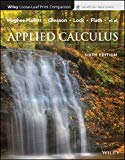
Applied Calculus, 6e WileyPLUS + Loose-leaf
6th Edition
ISBN: 9781119408901
Author: Deborah Hughes-Hallett, Andrew M. Gleason, Patti Frazer Lock, Daniel E. Flath
Publisher: Wiley (WileyPLUS Products)
expand_more
expand_more
format_list_bulleted
Question
Chapter 10.2, Problem 7P
To determine
(a)
Find the amount that must be deposited now if the endowment is to fund one award each year, with one award now and counting until twenty awards have been made.
To determine
(b)
Find the amount that must be deposited now if the endowment is to fund one award each year, with one award now and counting forever.
Expert Solution & Answer
Want to see the full answer?
Check out a sample textbook solution
Students have asked these similar questions
Solve the following heat equation by method of separation variables:
ди
=
at
subject to
u(0,t) =0, for
-16024
ძx2 •
t>0, 0 0,
ux (4,t) = 0, for
t> 0,
u(x, 0) =
(x-3,
\-1,
0 < x ≤2
2≤ x ≤ 4.
ex
5.
important aspects.
Graph f(x)=lnx. Be sure to make your graph big enough to easily read (use the space given.) Label all
6
33
Decide whether each limit exists. If a limit exists, estimate its
value.
11. (a) lim f(x)
x-3
f(x) ↑
4
3-
2+
(b) lim f(x)
x―0
-2
0
X
1234
Chapter 10 Solutions
Applied Calculus, 6e WileyPLUS + Loose-leaf
Ch. 10.1 - Prob. 1PCh. 10.1 - Prob. 2PCh. 10.1 - Prob. 3PCh. 10.1 - Prob. 4PCh. 10.1 - Prob. 5PCh. 10.1 - Prob. 6PCh. 10.1 - Prob. 7PCh. 10.1 - Prob. 8PCh. 10.1 - Prob. 9PCh. 10.1 - Prob. 10P
Ch. 10.1 - Prob. 11PCh. 10.1 - Prob. 12PCh. 10.1 - Prob. 13PCh. 10.1 - Prob. 14PCh. 10.1 - Prob. 15PCh. 10.1 - Prob. 16PCh. 10.1 - Prob. 17PCh. 10.1 - Prob. 18PCh. 10.1 - Prob. 19PCh. 10.1 - Prob. 20PCh. 10.1 - Prob. 21PCh. 10.1 - Prob. 22PCh. 10.1 - Prob. 23PCh. 10.1 - Prob. 24PCh. 10.1 - Prob. 25PCh. 10.1 - Prob. 26PCh. 10.1 - Prob. 27PCh. 10.1 - Prob. 28PCh. 10.1 - Prob. 29PCh. 10.1 - Prob. 30PCh. 10.2 - Prob. 1PCh. 10.2 - Prob. 2PCh. 10.2 - Prob. 3PCh. 10.2 - Prob. 4PCh. 10.2 - Prob. 5PCh. 10.2 - Prob. 6PCh. 10.2 - Prob. 7PCh. 10.2 - Prob. 8PCh. 10.2 - Prob. 9PCh. 10.2 - Prob. 10PCh. 10.2 - Prob. 11PCh. 10.2 - Prob. 12PCh. 10.2 - Prob. 13PCh. 10.2 - Prob. 14PCh. 10.2 - Prob. 15PCh. 10.2 - Prob. 16PCh. 10.2 - Prob. 17PCh. 10.2 - Prob. 18PCh. 10.2 - Prob. 19PCh. 10.2 - Prob. 20PCh. 10.3 - Prob. 1PCh. 10.3 - Prob. 2PCh. 10.3 - Prob. 3PCh. 10.3 - Prob. 4PCh. 10.3 - Prob. 5PCh. 10.3 - Prob. 6PCh. 10.3 - Prob. 7PCh. 10.3 - Prob. 8PCh. 10.3 - Prob. 9PCh. 10.3 - Prob. 10PCh. 10.3 - Prob. 11PCh. 10.3 - Prob. 12PCh. 10.3 - Prob. 13PCh. 10.3 - Prob. 14PCh. 10.3 - Prob. 15PCh. 10.3 - Prob. 16PCh. 10.3 - Prob. 17PCh. 10.3 - Prob. 18PCh. 10.3 - Prob. 19PCh. 10.3 - Prob. 20PCh. 10 - Prob. 1SYUCh. 10 - Prob. 2SYUCh. 10 - Prob. 3SYUCh. 10 - Prob. 4SYUCh. 10 - Prob. 5SYUCh. 10 - Prob. 6SYUCh. 10 - Prob. 7SYUCh. 10 - Prob. 8SYUCh. 10 - Prob. 9SYUCh. 10 - Prob. 10SYUCh. 10 - Prob. 11SYUCh. 10 - Prob. 12SYUCh. 10 - Prob. 13SYUCh. 10 - Prob. 14SYUCh. 10 - Prob. 15SYUCh. 10 - Prob. 16SYUCh. 10 - Prob. 17SYUCh. 10 - Prob. 18SYUCh. 10 - Prob. 19SYUCh. 10 - Prob. 20SYUCh. 10 - Prob. 21SYUCh. 10 - Prob. 22SYUCh. 10 - Prob. 23SYUCh. 10 - Prob. 24SYUCh. 10 - Prob. 25SYUCh. 10 - Prob. 26SYUCh. 10 - Prob. 27SYUCh. 10 - Prob. 28SYUCh. 10 - Prob. 29SYUCh. 10 - Prob. 30SYU
Knowledge Booster
Learn more about
Need a deep-dive on the concept behind this application? Look no further. Learn more about this topic, calculus and related others by exploring similar questions and additional content below.Similar questions
- Determine whether the lines L₁ (t) = (-2,3, −1)t + (0,2,-3) and L2 p(s) = (2, −3, 1)s + (-10, 17, -8) intersect. If they do, find the point of intersection.arrow_forwardConvert the line given by the parametric equations y(t) Enter the symmetric equations in alphabetic order. (x(t) = -4+6t = 3-t (z(t) = 5-7t to symmetric equations.arrow_forwardFind the point at which the line (t) = (4, -5,-4)+t(-2, -1,5) intersects the xy plane.arrow_forward
- Find the distance from the point (-9, -3, 0) to the line ä(t) = (−4, 1, −1)t + (0, 1, −3) .arrow_forward1 Find a vector parallel to the line defined by the parametric equations (x(t) = -2t y(t) == 1- 9t z(t) = -1-t Additionally, find a point on the line.arrow_forwardFind the (perpendicular) distance from the line given by the parametric equations (x(t) = 5+9t y(t) = 7t = 2-9t z(t) to the point (-1, 1, −3).arrow_forward
- Let ä(t) = (3,-2,-5)t + (7,−1, 2) and (u) = (5,0, 3)u + (−3,−9,3). Find the acute angle (in degrees) between the lines:arrow_forwardA tank initially contains 50 gal of pure water. Brine containing 3 lb of salt per gallon enters the tank at 2 gal/min, and the (perfectly mixed) solution leaves the tank at 3 gal/min. Thus, the tank is empty after exactly 50 min. (a) Find the amount of salt in the tank after t minutes. (b) What is the maximum amount of salt ever in the tank?arrow_forwardpleasd dont use chat gptarrow_forward
arrow_back_ios
SEE MORE QUESTIONS
arrow_forward_ios
Recommended textbooks for you

Solve ANY Optimization Problem in 5 Steps w/ Examples. What are they and How do you solve them?; Author: Ace Tutors;https://www.youtube.com/watch?v=BfOSKc_sncg;License: Standard YouTube License, CC-BY
Types of solution in LPP|Basic|Multiple solution|Unbounded|Infeasible|GTU|Special case of LP problem; Author: Mechanical Engineering Management;https://www.youtube.com/watch?v=F-D2WICq8Sk;License: Standard YouTube License, CC-BY
Optimization Problems in Calculus; Author: Professor Dave Explains;https://www.youtube.com/watch?v=q1U6AmIa_uQ;License: Standard YouTube License, CC-BY
Introduction to Optimization; Author: Math with Dr. Claire;https://www.youtube.com/watch?v=YLzgYm2tN8E;License: Standard YouTube License, CC-BY